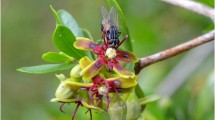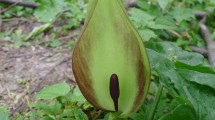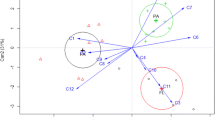Abstract
In sapromyiophilous plants, up to date, long range attraction of fly pollinators has been thoroughly investigated and attributed to “fetid” floral compounds, while the “sweet” floral scent fraction has not been specifically investigated and its role has received little attention. The aim of the present study was to verify if terpenoids, which are the main compounds of the floral bouquet of Caralluma europaea, play a role in the attraction of its pollinator Musca domestica. Terpinolene, α-terpinene and linalool, described as the three main volatiles of the flowers of C. europaea, were evaluated in electrophysiological investigations and blends of these compounds as well as the whole fresh flowers were used in behavioural assays. Antennae of housefly adults showed positive dose-dependent responses to all the chemicals tested. Houseflies were attracted by the odour of the fresh flowers and by the reconstructed terpenoid blend at the dose of 100 μg. At the dose of 10 μg, the blend did not produce any attraction. The results of the present study support the hypothesis that terpinolene, α-terpinene and linalool emitted by C. europaea flowers are involved in pollinator attraction and demonstrate the importance of the “sweet” scent in this sapromyiophilous species.


Similar content being viewed by others
References
Asclepol database. Germany Department of Plant Systematics, University of Bayreuth. Available: http://www.uni-bayreuth.de/departments/planta2/research/pollina/as_pol_t.html. Accessed 11 March 2013
Cossé AA, Baker TC (1996) House flies and pig manure volatiles: wind tunnel behavioral studies and electrophysiological evaluations. J Agric Entomol 13:301–317
de Weerdt CJ, Kelling FJ (2001) Electrophysiological characteristics of olfactory receptors of different strains of Musca domestica. Proc Exp Appl Entomol, Nev Amsterdam 12:71–73
Dobson HEM (2006) Relationship between floral fragrance composition and type of pollinator. In: Dudareva NA, Pichersky E (eds) Biology of floral scent. CRC Press Taylor & Francis Group, London, UK, pp 147–198
Formisano C, Senatore F, Della Porta G, Scognamiglio M, Bruno M, Maggio A, Rosselli S, Zito P, Sajeva M (2009) Headspace volatile composition of the flowers of Caralluma europaea N.E. Br. (Apocynaceae). Molecules 14:4597–4613
Hwang YS, Kramer WL, Mulla MS (1980) Oviposition attractants and repellents of mosquitoes. Isolation and identification of oviposition repellents for Culex mosquitoes. J Chem Ecol 6:71–80
Jürgens A, Dötterl S, Meve U (2006) The chemical nature of fetid floral odours in stapeliads (Apocynaceae–Asclepiadoideae–Ceropegieae). New Phytol 172:452–468
Kelling FJ, Biancaniello G, den Otter CJ (2002) Electrophysiological characterization of olfactory cell types in the antennae and palps of the housefly. J Insect Physiol 48:997–1008
Kite GC, Hetterscheid WLA (1997) Inflorescence odours of Amorphophallus and Pseudodracontium (Araceae). Phytochemistry 46:71–75
Kite GC, Hetterscheid WLA, Lewis MJ, Boyce PC, Ollerton J, Cocklin E, Diaz A, Simmonds MSJ (1998) Inflorescence odours and pollinators of Arum and Amorphophallus (Araceae). In: Owens SJ, Rudall PJ (eds) Reproductive biology. Royal Botanic Gardens, Kew, UK, pp 295–315
Krcmar S (2007) Responses of Tabanidae (Diptera) to canopy traps baited with 4-methylphenol, 3-isopropylphenol, and naphthalene. J Vector Ecol 32:188–192
Kugler H (1956) Über die optische Wirkung von Fliegenblumen auf Fliegen. Berichte der Deutschen Botanischen Gesellschaft 64:327–341
Lam K, Tsang M, Labrie A, Gries R, Gries G (2010) Semiochemical-mediated oviposition avoidance by female house flies, Musca domestica, on animal feces colonized with harmful fungi. J Chem Ecol 36:141–147
Larson BMH, Kevan PG, Inouye DW (2001) Flies and flowers: the taxonomic diversity of anthophiles and pollinators. Can Entomol 133:439–465
Meve U, Heneidak S (2005) A morphological, karyological and chemical study of the Apteranthes (Caralluma) europaea complex. Biol J Linn Soc 149:419–432
Meve U, Liede S (1994) Floral biology and pollination in stapeliads—new results and a literature review. Plant Syst Evol 192:99–116
Ollerton J, Raguso RA (2006) The sweet stench of decay. New Phytol 172:382–385
Ollerton J, Masinde S, Meve U, Picker M, Whittington A (2009) Fly pollination in Ceropegia (Apocynaceae: Asclepiadoideae): Biogeographic and phylogenetic perspectives. Ann Bot 103:1501–1514
Pisciotta S, Raspi A, Sajeva M (2011) First records of pollinators of two co-occurring Mediterranean Apocynaceae. Plant Biosyst 145:141–149
Roy BA, Raguso RA (1997) Olfactory versus visual cues in a floral mimicry system. Oecologia 109:414–426
StatSoft Inc. (2004) STATISTICA (Data Analysis Software System), Version 7. http://www.statsoft.com
Sukontason K, Sukontason KL, Piangjai S, Boonchu N, Chaiwong T, Ngern-klun R, Sripakdee D, Vogtsberger RC, Olson JK (2004) Antennal sensilla of some forensically important flies in families Calliphoridae, Sarcophagidae and Muscidae. Micron 35:671–679
Urru I, Stensmyr MC, Hansson BS (2011) Pollination by brood-site deception. Phytochemistry 72:1655–1666
Zito P, Sajeva M (2011) Caralluma europaea on Lampedusa Island. Asklepios 112:3–14
Acknowledgements
The authors are indebted to Prof., Dr. Stefan Dötterl for his critics, corrections, suggestions and attention.
Author information
Authors and Affiliations
Corresponding author
Additional information
Handling Editor: Stanislav Gorb.
Rights and permissions
About this article
Cite this article
Zito, P., Guarino, S., Peri, E. et al. Electrophysiological and behavioural responses of the housefly to “sweet” volatiles of the flowers of Caralluma europaea (Guss.) N.E. Br.. Arthropod-Plant Interactions 7, 485–489 (2013). https://doi.org/10.1007/s11829-013-9270-3
Received:
Accepted:
Published:
Issue Date:
DOI: https://doi.org/10.1007/s11829-013-9270-3




